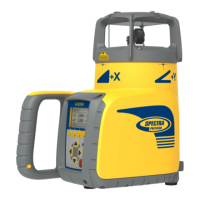21
9 CALIBRATION
9.1 Checking Calibration of the Y- and X-Axes
1. Set up the laser 30 m (100 ft) from a wall and allow it to level.
2. Setthegradeto0.000%inbothaxes.
3. Raise/lowerthereceiveruntilyougetanon-gradereadingforthe+Yaxis.Using
the on-grade marking notch as a reference, make a mark on the wall.
Note: Forincreasedprecision,usethesuperne-sensitivitysetting(1.0mm/1/16
in.) on the receiver.
4.Rotatethelaser180°(-Yaxistowardthewall)andallowthelasertore-level.
5.Raise/lowerthereceiveruntilyougetanon-gradereadingforthe–Y/axis.Usingthe
on-grade marking notch as a reference, make a mark on the wall.
6.Measurethedifferencebetweenthetwomarks.Iftheydiffermorethan3mmat30
m(1/8inchat100feet),thelaserneedscalibrating.
7.AftercheckingtheY-axis,rotatethelaser90°.Repeattheabovestartingwiththe
+Xaxisfacingthewall.
9.2 Checking Calibration of the Z-(vertical) Axis
To check vertical calibration, you need a plumb bob with at least 10m (30ft) of string.
1. Suspend the plumb bob in front of a house i.e., attached to a window frame whose window height is at least
10m (30ft).
2.Setupthelaserinverticalsothatthelaserbeamstrikesthereceiver’son-gradepositionatthetopofthestring.
3.Lookforanydeviationusingthereceiverfromthetopofthestringtothebottomofit.Ifthedeviationismore
than1mm(<1/16in.),theverticalaxisneedscalibrating.

